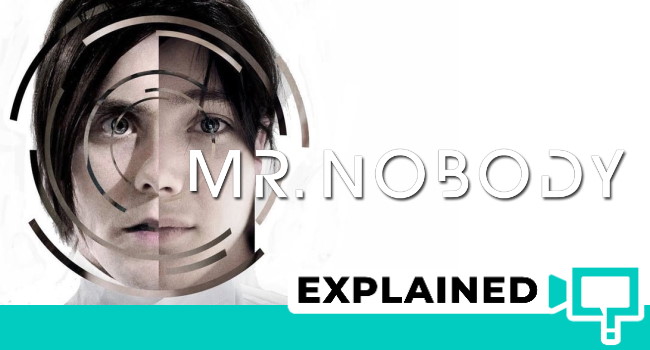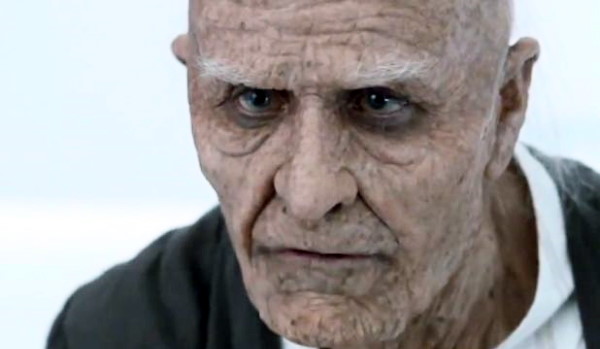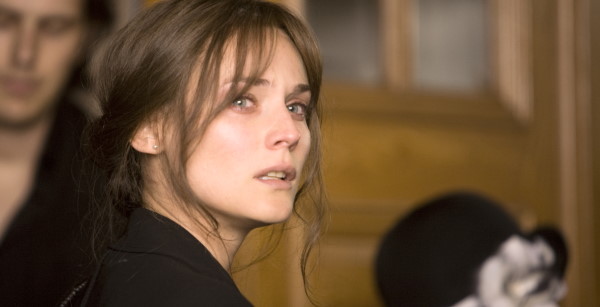During its ten years of production, Mr. Nobody (2009), a romantic fantasy directed by Jaco Van Dormel, became the main hope of European auteur cinema, but this film made a mixed impression. Some people found an empty pathos of eternal questions without any attempt at a clear answer, but for others, the film was a revelation and gave them a new perspective on their lives. Here’s the plot and ending of the movie Mr. Nobody explained; spoilers ahead.
Contents
Here are links to the key aspects of the movie:
- – Plot Explained
- – Choice 1: Growing up with his mother
- – Choice 2: Growing up with his father
- – Choice X: Nemo was never born
- – Analyzing Themes And Concepts
- – Plato
- – The Problem of Choice
- – Determinism
- – The Butterfly Effect
- – Who am I?
- – Rational vs. Emotional
- – Ending Explained
- – True Choice and True Freedom
Mr. Nobody: Plot Explained
The main character Mr. Nobody (or Nemo), wakes up in the not-too-distant future. He’s 118 years old, and he’s the last mortal man on Earth whose final days are watched by TV viewers. All other people are immortal because their cells are artificially renewed.
Nemo confidently declares that he remembers nothing of his past. At the same time, the film itself is a slice of the different versions of his life that he could have lived.
Nemo first made his choice when he was very young. His parents were getting a divorce, and he had to decide who to stay with. All of this transpires at a railway station. Let’s step into Nemo’s choices and their consequences.
Mr. Nobody: Choice 1: Growing up with his mother
Meeting Anna
One day, a girl named Anna shows up in Nemo’s class. At the beach, Anna invites Nemo to swim, but he doesn’t know how to.
In one reality, Nemo tells Anna, “I do not swim with the fools“, ending his relationship with her at once.
In another reality, Nemo admits to Anna that he does not know how to swim. After that, the two become very close and realize that their parents are dating and lose touch when their parents break up. Years later, they meet, but fate sees to it that Nemo loses Anna’s number because of the rain. After that, he endlessly waits at a lighthouse where Anna proposes they meet.
Mr. Nobody: Choice 2: Growing up with his father
Dad says you can predict exactly when Mars will appear in the sky even a hundred years from now. The funny thing is that Dad has no idea what will happen to him in two minutes.
Nemo lives and takes care of his ailing father.
Meeting Elise
Nemo works part-time at the store. One day at a dance party, he meets a girl named Elise and immediately falls in love with her.
In one reality, Nemo meets Elise at her home, and she says that she’s in love with someone else. Nemo is persistent and eventually wins her over. The two marry, but Elise dies right after.
In another reality, Elise and Nemo go on to have three kids, but their lives are an empty wreck, with Elise developing depression eventually leaving.
Alternately, Nemo arrives at Eliza’s house and sees her with her boyfriend, which upsets him greatly, and he doesn’t tell her about his feelings. Nemo crashes his motorcycle ends up in a coma. Nemo then has delusions of his parents getting back at his bedside. This appears to be one of his deepest desires.
Meeting Jean
I’ll marry the first girl who dances with me.
After being rejected by Eliza, Nemo decides to marry the first girl who dances with him, and he meets Jean. They wed and have kids, but Nemo leaves her. After that, he lives his life erratically, making decisions using a coin. Finally, Nemo gets murdered by assassins because of mistaken identity.
Mr. Nobody: Choice X: Nemo was never born
In one of the realities, Nemo was simply not born; his parents never met.
Until the choice is made, everything in the world is possible.
Mr. Nobody Explained: Analyzing Themes And Concepts
Plato
The film begins with a prologue in which we are told that a person knows his whole life before birth. But just before the baby is born, an angel touches the child’s lips, and it forgets everything.
It directly refers to an idea of the ancient Greek philosopher Plato. He believed that the human soul is immortal and possesses the fullness of truth about the world. But before being embodied in a body, it drinks from the river of oblivion Letha. And all we do in our earthly life is recall the knowledge we already have. There is a scene where the children are immersed in the water – just referring us to this story.
The main character’s peculiarity is that the angel has not touched him, and he has not lost his knowledge. Therefore, he is the only person who can remember the future because it is already known to him.
The Problem of Choice
The central theme of the film is the problem of choice. First, Nemo chooses the parents in whose family he will be born. And then, he faces the choice of which parent he will stay with in the divorce. The separation scene at the train station is key to understanding the film. Here, a crossroads is formed with two possible vectors of the protagonist’s life – his father or mother. The little boy begins to think about his future in all the possible options, which we see throughout the film. In each reality, there are further options for the development of events. And what do they depend on? As we can see, on chance.
Determinism
The first thing that comes to mind when watching this movie is the idea of determinism. It is a concept that speaks of the existence of a single cause and effect relationship. Determinism assumes that if we calculate the position of every particle in the world, we will know both the past and the future.
But in Mr. Nobody, there is no predetermination. The world is presented as a set of infinitely multiplying accidents, the interconnection of which is explained by the Butterfly Effect.
The Butterfly Effect
The butterfly effect was formulated by the American mathematician and meteorologist Edward Lorenz (1917-2008). It is a property of a chaotic system where the slightest change can lead to global catastrophe. A famous example is a butterfly flapping its wing in America can lead to a tornado in Indonesia.
Throughout the film, we see the Butterfly Effect in action:
- An eggshell leads to tragedy.
- A torn shoelace affects his life choices.
- A digested egg leads to rain that washes away a phone number written on paper.
We are constantly shown how any event can lead to entirely unpredictable consequences. For example, if the wind had not ripped the leaf from the tree and left it on the sidewalk, the main character’s father would not have slipped on it and met the mother.
But then what is a person to do in a world full of accidents? Choose.
Who am I?
Looking at the thousands of options for his future life, the hero inevitably wonders: where is the real him among these options? And the film gives us the answer: it is choice that makes us who we are.
Sartre once said: “What is important is not what happens to us, but how we respond to what happens to us.” In other words, the French existentialist philosopher tells us that circumstances do not determine us. The decisive word is always ours, and we choose our destiny; an essay service to show how crucial personal responsibility is for our life.
The film shows us a man who can see a thousand options for the future, but he still has to make the critical choice himself. The director is also trying to show us two sides of Nemo’s choice – the rational and the emotional.
Rational vs. Emotional
Staying with his father – Nemo does not stay with his father because of inner compulsion but because of an accidental external factor. And in this branch of the story, he performs rational, externally conditioned actions rather than coming from within his being.
For example, Nemo makes choices with a coin, i.e., relying on chance. In this position in life, a personal will is disconnected, the pursuit of happiness is absent, and Nemo simply drifts with the current.
Nemo decides to marry the girl who will dance with him. It is a rational decision, too, itself random and relying on chance. Nemo then defines happiness for himself as outward wealth and well-being. This understanding of happiness is conditioned by society’s accepted notions of a happy life.
Leaving with his mother – In the storyline where Nemo goes with his mother, he follows his heart’s call.
The director emphasizes that choice must not stem from indifference but must come from the heart and be driven by the desire for good (love for Anna). Nevertheless, in none of the other branches does Nemo attain happiness. And so, in the director’s opinion, a choice based on feelings is also unsatisfactory.
In all the versions of the lives we are shown throughout the film, Nemo comes to different downbeat endings.
Mr. Nobody: Ending Explained
The ending of the movie Mr. Nobody has Nemo explaining that these alternate realities are merely the result of a 9-year-old kid facing an incomprehensible choice. Each one leads to one disaster or the other; no happy ending. Nemo didn’t make a choice; he went with neither of his parents. While that might have led to a miserable childhood, Nemo eventually found peace and a life partner.
True Choice and True Freedom
The director conveys that a genuinely free choice is not one where you pick from a list. This is not freedom because the options themselves are limiting, and external factors determine our will.
A genuinely free choice comes from within us, rises above external limitations, and creatively transforms our lives.
Having recalled all the possible options in his life, Nemo rises above the situation limited by his parents’ choice of two options and takes a third, his own path. Undoubtedly, this act symbolizes maturing and transitioning to self-sufficiency as Nemo reaches true freedom.
This act of an adult based on the determination to make a choice not conditioned by parental prescriptions or conventional notions of happiness or chance leads Nemo to happiness, depicted by his meeting with Anna in the end.
Thus, the film’s central message is that we must take our destiny into our own hands and make our choices, no matter what. There is no predestination, and we are free to live life as we see fit.
Until the choice is made, everything in the world is possible.

Barry is a technologist who helps start-ups build successful products. His love for movies and production has led him to write his well-received film explanation and analysis articles to help everyone appreciate the films better. He’s regularly available for a chat conversation on his website and consults on storyboarding from time to time.
Click to browse all his film articles





